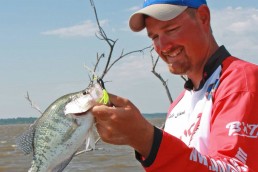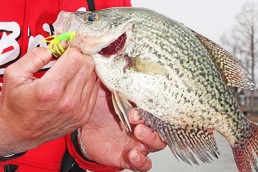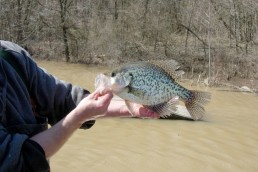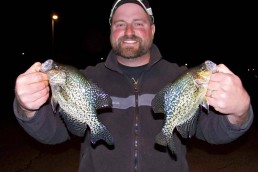Crappie Tubes Should Not be Forgotten
SHARE THIS POST
Crappie tubes have been around forever, but in the past few years the shads, minnows, stingers, critters and baits with many other names have seemed to take over the crappie market. Tubes are not, nor should be, forgotten.
The truth is in the catching. Some days a live minnow will catch more fish and other days jigs can do the trick. Crankbaits, spoons and waxworms are also good baits under certain situations. No one bait is always the best, but a tube jig has proven its worth and will continue to do so.
Why a tube?
A tube is a hollow piece of soft plastic. The baits are typically 1 1/2 to 2 inches long and 1/4 inch in diameter. The body is soft and adds much to the color scheme of the jig. The tail is the magic part with the classic jig having multiple tentacle tails that give the bait its action. This bait comes alive when it’s danced, hopped and even when held relatively still. The tube mimics something that is alive.
Compared to minnow, it has many adavantages. You don’t have to buy them each trip to the lake and the ones left over don’t have to be tossed. They also don’t have to be kept alive in the summer when minnows have a tendancy to die. And, a jig doesn’t have to be changed after each bite or caught crappie.
Catching crappies
A jig isn’t magic, so the first step is to get into an area with crappies. The depth and type of area will determine the method you use. Mix your personal preference of technique with the right one for the area and go to work. Experts agree that several things are important. The most important factor is to have it in the strike zone. Use a jig weight that will get to the strike zone and have as slow a fall as practical. For example, crappies in 1 to 5 feet of water calls for a 1/32-ounce jig. The slow fall will trigger the maximum number of bites. Going down deeper—6 to 12 feet—use a 1/16-ounce jig to get to the strike zone and still maintain a moderate fall rate. A 1/8-ounce jig is good for deeper water, and has a fast fall rate so it will draw few bites on the fall but it doesn’t waste time getting to the strike zone.
Wieghts need to be modified to conditions; jigs need to be heavier if current is present. A major problem is wind because of the bow in the line and less control of the bait, so jig weight must be increased, if necessary, to have control of the bait.
On the opposite end of the scale is downsizing due to lethargic fish. It might be a cold front or very cold water. For example, in winter you might need a small tube and a 1/32-ounce jig in 20 feet of water. That means extreme patience and finesse. Ice fishermen need tiny jigs, but not as much for open water. A few 1 1/4-inch baits are used, but 1 1/2 to 2 inches is the basic jig for clearer water and lakes with small to average crappies. During the last decade, especially in the South and Midwest, there has been a trend toward bigger baits. A 3-inch bait is not too big for a large crappie, and many are using 3-inch baits for a big profile with a “big-baits-catches-big-fish” theory.
Many choices can make it confusing, but talking to a few local fishermen can let you know what the crappies in a particular lake prefer. Make that size your primary jig, but don’t hesitate to use both larger and smaller baits to give crappies an option.
Are you enjoying this post?
You can be among the first to get the latest info on where to go, what to use and how to use it!
More tube tips
The best tube fishing tip was told to me by a great jig fisherman and guide: “Fish a jig like you would a minnow; the less action the better.”
He said most fishermen put too much action in a bait. You don’t see minnows jumping up and down in the water in 6-inch hops so your jig shouldn’t do that either. Make it look like a shad or a minnow in the water.
Colors can be discussed forever. The rule is bright colors in clear water and bright conditions and dark colors in stained or dingy water and dark conditions. The key is to have a variety. An example of a simple kit would be light colors in white, light pink, milk/shad with flakes and medium colors in orange-chartreuse, blue-white, lime-green-chartreuse glow and finally dark colors in purple-chartreuse or black-chartruese glow.
Scent matters; use an attractant. You can catch fish without it, but you’ll catch more with it. Soft pellet scents, including Berkley Crappie Nibbles, are great, but they have to be replaced often. A good gel scent to use is Bobby Garland MoGlo Slab Jam and it stays on long.
Final comments
Tube jigs are a great go-to generic crappie bait. You can get them short, long, slim, fat, plain or blinged-out with sparkle and glow. Part of the fun of crappie fishing is picking the right bait and experimenting and finding just the right one.
Again, tube jigs are less trouble than minnows, but perhaps the best advantage is the ability to fish them in places you can’t get a minnow. The thicker the cover, the easier it is then to fish a jig.
There are many good tubes, so what if I were restricted to three jig colors in my boat? It would depend upon the lake, but there are three versatile choices including a lighter color in pale pink-white, a medium color like the lime-chartreuse with an orange head, and dark colors like the black-chartreuse glow with an orange head.
MWO
SHARE THIS POST
Did you enjoy this post?
You can be among the first to get the latest info on where to go, what to use and how to use it!
Tim Huffman
Tim Huffman specializes in crappie fishing, is editor for two crappie magazines, as well as writing for several others. In 2018, he published his sixth book, Limiting Out for Crappie, available at Amazon. His first article appeared in MidWest Outdoors in 1988.



